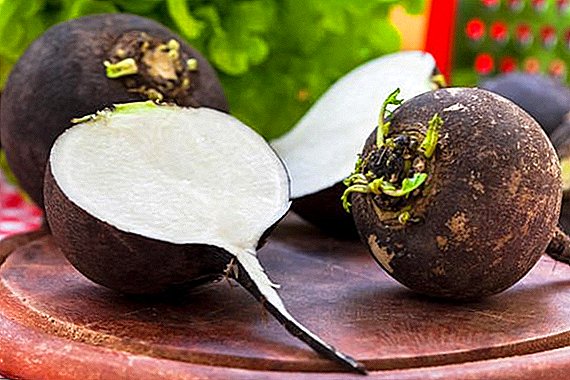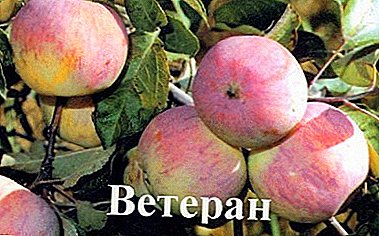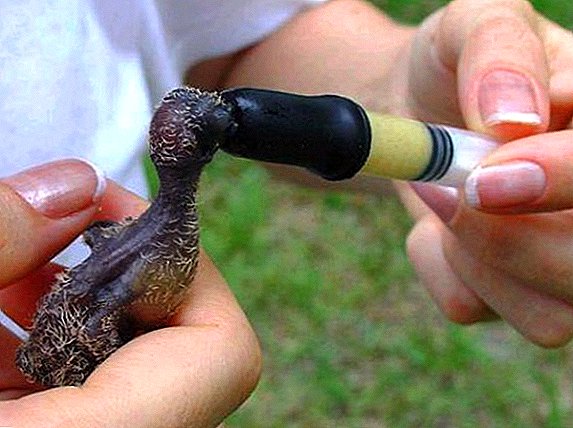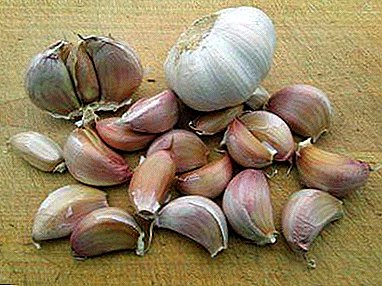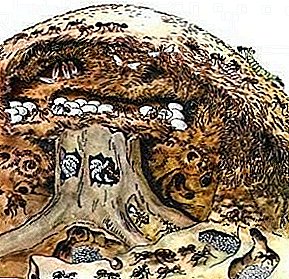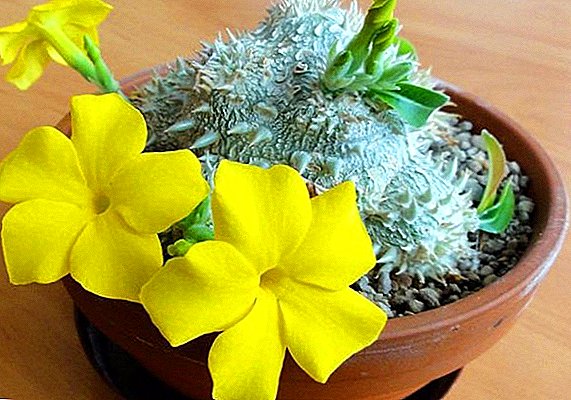 Pachypodium in natural conditions prefers dry and secluded corners of hills and highlands. Exotic plant is distributed in some African countries, Madagascar and Australia. Flower growers fell in love with a hybrid tree with a cactus plant for an unusual look. In this article we will get acquainted with pachypodium, we will consider a photo of a plant and its popular types.
Pachypodium in natural conditions prefers dry and secluded corners of hills and highlands. Exotic plant is distributed in some African countries, Madagascar and Australia. Flower growers fell in love with a hybrid tree with a cactus plant for an unusual look. In this article we will get acquainted with pachypodium, we will consider a photo of a plant and its popular types.
Short stem
The distribution area of the island of Madagascar. This species is on the verge of extinction due to frequent fires in places of growth. It is low, slightly more than 10 cm in height, but expands in width to 60 cm, prefers sandy soils.  Outwardly, this pseudo-cactus resembles a shapeless, overgrown tuber of a light gray color, from which bright green leaves stick out on short petioles. The leaf is oblong in shape, clearly divided in the center by a light vein, the surface of the foliage is smooth.
Outwardly, this pseudo-cactus resembles a shapeless, overgrown tuber of a light gray color, from which bright green leaves stick out on short petioles. The leaf is oblong in shape, clearly divided in the center by a light vein, the surface of the foliage is smooth.
Pachypodium is referred to as succulent plants. This group also includes: havortia, agave, adenium, aihrizone, zamiokulkas, kalanchoe, euphorbia, fat woman, yucca, aloe, lithops, nolina, echeveria, stapelia, echinocactus.
During the flowering period is covered with bright yellow flowers on short peduncles. Flowers have an unusual shape: five rounded petals are revealed from a conical elongated bell. The plant loves good light, moderate humidity and warmth. 
Zhayi
In nature, this tree is up to 8 m in height, at home about half a meter. The trunk of the plant is voluminous, thick, gray-green in color, all studded with prickles that grow from one bud, 2-3 pieces each, spikes silver-gray. If you look at pachypodium from a distance, then it seems to be covered with down from the abundance of spines, by the way, this species looks like a kind of lamer, you can compare photos.  Around the middle of the trunk, dark green leaves grow randomly. Thin leaves have a sharp tip and light edge. On the center of a leaf plate there passes a light strip.
Around the middle of the trunk, dark green leaves grow randomly. Thin leaves have a sharp tip and light edge. On the center of a leaf plate there passes a light strip.
It blooms with white bells. At home, blooms at the age of ten with proper care. He likes bright light and moisture in the spring-summer season. In the house the plant rarely forks, grows actively, but not higher than 60 cm. 
Sanders
This variety is also called the Star of Lundi, the continental Africa is the birthplace of the plant.
The gray-green spiny trunk of the pachypodium of sanders resembles an elongated potato. The spikes on the stem are not very densely, but 2-3 in a heap, their length is up to 2.5 cm. Bright green leaves with a glossy surface grow from the stem in a scattered form. The shape of the plates is a wide oval with an elongated base and a sharp tip. The edges of the leaves may have a slight waviness or a notch, with a light streak in the center.  Sanders blooms beautifully: there are white, pink and red flowers. As the stem grows, it can split into 3-4 shoots. In the care prefers low humidity, bright lighting and temperature from 18 ° C to 22 ° C.
Sanders blooms beautifully: there are white, pink and red flowers. As the stem grows, it can split into 3-4 shoots. In the care prefers low humidity, bright lighting and temperature from 18 ° C to 22 ° C.
Lamera
This pachypodium is deservedly called the Madagascar palm, as can be seen in the photo, the plant is really a miniature palm tree, though it is prickly. In its natural environment, it is a large tree about 8 m tall.  The cylindrical form of a gray-green curved stem often gives lateral processes, but these processes are not suitable for reproduction, since they practically do not root. From the buds located along the entire surface of the trunk spikes grow in three from one bud.
The cylindrical form of a gray-green curved stem often gives lateral processes, but these processes are not suitable for reproduction, since they practically do not root. From the buds located along the entire surface of the trunk spikes grow in three from one bud.
The leaves are long and narrow, bright green with a shiny surface and a short petiole, their length is up to 15 cm, and the width is not more than 2 cm. The leaves grow only in the upper part of the trunk, which gives a similarity to a palm tree.  Flowers are more creamy with a yellow center. Madagascar palm tree does not tolerate low temperatures, is not afraid of the direct rays of the sun, likes moderate moisture with soft water.
Flowers are more creamy with a yellow center. Madagascar palm tree does not tolerate low temperatures, is not afraid of the direct rays of the sun, likes moderate moisture with soft water.
Important! Due to an excess of moisture, pachipodium lamer can get root rot and it is extremely difficult to cure the plant.
Succulet
A species originally from South Africa.  Partially lignified central part of the trunk at the top is dotted with young bright green, branched shoots that reach a length of just under a meter. The shoots are mostly bare, not counting the yellowish, sharp spines, and the top are small, elongated shape with a sharp tip of the leaves. The upper side of them is smooth, dark green, the bottom - fleecy.
Partially lignified central part of the trunk at the top is dotted with young bright green, branched shoots that reach a length of just under a meter. The shoots are mostly bare, not counting the yellowish, sharp spines, and the top are small, elongated shape with a sharp tip of the leaves. The upper side of them is smooth, dark green, the bottom - fleecy.
In the period of flowering at the top of the stems pink flowers bloom, and sometimes with a purple tint flowers, with a bright tubular middle.
In winter, leaves growing in small groups move closer to the top, exposing the stems, but this is a natural behavior in the dormant period. 
Did you know? According to the teachings of Feng Shui, pachipodium protects the house from negative energy. The Chinese use the fleshy leaves of some varieties to relieve pain during inflammatory processes in the body.
Namakwan
This plant is most of all similar to a cactus with leaves, so thickly studded with red-brown needles, that behind them it is difficult to distinguish the color of the trunk. Greenish-gray thick round column as a cap crowned with a cap of gray-green leaves. The shape of the foliage is elongated, the edges are wavy and curved in the middle of the upper side.  In nature, flower stalks with dark-purple bells grow from the center of the foliar bundle. At home, flowering - a rarity.
In nature, flower stalks with dark-purple bells grow from the center of the foliar bundle. At home, flowering - a rarity.
It is noteworthy that in willow under natural and indoor conditions, the speed of growth and development is approximately the same, although the flower does not grow in a house more than one and a half meters. To accelerate growth, growers are advised to plant a plant.
Bispinozum (dvukholyuchkovy)
The thickened above-ground formation looks like an overgrown turnip, has a height of more than half a meter, it is smooth, light brown in color, without thorns.
From the top of the thickened stem grow thin, strong stems of gray-green color, densely dotted with paired prickles and dense fleshy leaves. The foliage is small, lanceolate, bright green, glossy.  Blooms pink and light shades of purple and violet. Bells in the expanded form up to 2 cm in diameter, located at the very top of the stem.
Blooms pink and light shades of purple and violet. Bells in the expanded form up to 2 cm in diameter, located at the very top of the stem.
With a lack of moisture or lighting sheds leaves. During the winter period, no overcooling should be allowed; the temperature should not be lower than 15 ° C. Feeding is carried out no more than once a month with cacti complexes.
Densely flowered
The thick, round, greenish-gray trunk of the plant, forks as it grows. It is also densely covered with spines, but unlike other species, they more resemble thorns of roses than long needles of a cactus. In culture, growing no more than a meter. Foliage adorns only the tops of the stems. Leaf blades are elongated, with a rounded tip and central vein in the center, green.  During the flowering period, the top is covered with sunny yellow flowers. Inflorescences petals wavy along the edge, and in the middle there is a white-green cone, resembling an unblown flower.
During the flowering period, the top is covered with sunny yellow flowers. Inflorescences petals wavy along the edge, and in the middle there is a white-green cone, resembling an unblown flower.
The densely flowered pachypodium requires annual transplantation, good drainage in the tank and moderate humidity.
Did you know? Numerous spines are needed by the plant not only as a protection against insects and herbivores, but also as water collectors. Mist or precipitated dew, any atmospheric moisture is absorbed by spikes, replenishing the water in fleshy stems.
Southern
In the native habitat on the island of Madagascar, the plant reaches a height of three meters, in a pot - just over a meter. The brownish-gray trunk, round and thick in diameter, branches as it grows. It is noteworthy that the thorns grow only in the upper part of the trunk, the lower part is smooth. Externally, the structure of the bark of the trunk resembles woody.  Long and thin, bright green leaves with a glossy surface stretch straight up from the tops of the stems. Blooms large bells with a bright center, wavy petals curved down. Inflorescences usually pale pink or purple color.
Long and thin, bright green leaves with a glossy surface stretch straight up from the tops of the stems. Blooms large bells with a bright center, wavy petals curved down. Inflorescences usually pale pink or purple color.
Southern grows rapidly, so youngsters are transplanted annually, adult specimens once every three years. It is advisable to be careful with the root system: it is very fragile and fragile.
Rosette
A variety of rosette pachypodium differs in an interesting form of aerial formation. It looks like a silver-gray vessel with a few necks, from which greens protrude. The surface of the formation is smooth, and the green stems are simply covered with sharp thorns. The name of the species speaks for itself: the leafy mass grows with a rosette, the leaf plates are elongated, with a brilliant bright green surface. In the center of the sheet is a lighter band. Compact shrub grows no more than half a meter.  The inflorescences of this species shoot yellow bells, 3-4 flowers on one long pedicel.
The inflorescences of this species shoot yellow bells, 3-4 flowers on one long pedicel.
Important! When caring for a flower, pruning and transplanting, you need to work with gloves. The juice secreted by the cactus palm is poisonous; if it comes into contact with the skin, rinse immediately with water.
Rutenberg
A plant with a thick, cylindrical, tree-like stem, grows in Africa and Madagascar. In nature, the height of the trunk reaches 8 m, and a diameter of about half a meter.
At the very bottom of the trunk is smooth, dotted with wide, short spines above. The foliage grows more in the upper part, dense, fleshy, with a shiny surface and a longitudinal vein, of elongated shape, the color is dark green.  The species has beautiful large flowers: white or pale pink, with petals wavy at the edges and a yellow tubular core.
The species has beautiful large flowers: white or pale pink, with petals wavy at the edges and a yellow tubular core.
The plant needs constant spraying, otherwise in dryness it will be subject to spider mite attacks. Plants up to six years old need to be transplanted annually, older plants once every three years.
This exot will not leave anyone indifferent, its unusual appearance will surely attract attention. With careful care, decorating your home with pachipodium will be about 15 years.



